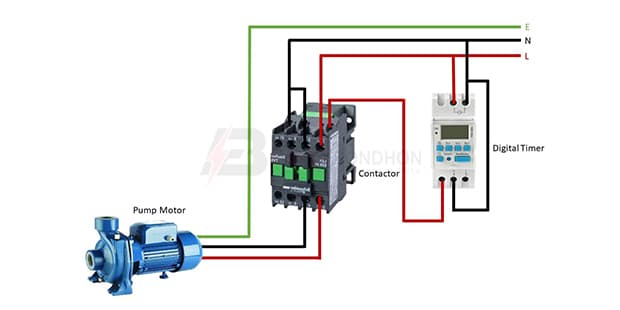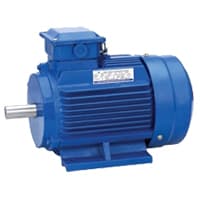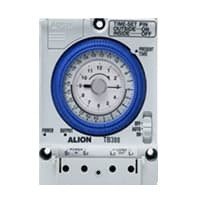Digital Timer switch in motor wiring:
This diagram shows how to make Digital Timer switch in motor wiring. In this circuit, we use a single-phase water pump motor, a magnetic contactor, and a digital timer. First, we need to connect the timer and contactor with a power source, then connect the water pump with the contactor connection. Now this circuit is ready for use. If you want to know more details about this circuit please check our youtube video below the post.
Advertisements
Components needed For this Project:
You can get the components from any of the sites below:
- Single Phase Motor (1 HP) [See Buy Click Amazon]
- Magnetic Contactor 40A [See Buy Click Amazon]
- Digital Timer 220V AC [See Buy Click Amazon]
*Please note: These are affiliate links. I may make a commission if you buy the components through these links. I would appreciate your support in this way!
Advertisements
Components used to make the Digital Timer switch in motor wiring:
A Single-Phase Motor is an Electrically-Powered Rotary Machine That Can Turn Electric Energy into Mechanical Energy. It Works by Using a Single-Phase Power Supply. Single-phase Motors Are Used in Equipment And Machines That Are Smaller in Size And Require Lower Horsepower. This Includes Equipment Such As Refrigerators, Pumps, Compressors, Fans, and Portable Drills. Single-phase motors Have a Similar Construction to The 3-phase Motor, Including an AC Winding That is Placed on The Stator And Short-Circuited Conductors That are Placed in a Cylindrical Rotor.
02. Magnetic Contactor:
A magnetic contactor is an electromagnetic switching device. It is generally used for controlling 3-phase Motors. The operation of a magnetic contactor is similar to that of a Relay. but a relay is used for low-power or low-voltage connections, and a magnetic contactor is used for high-power or high-voltage connections. As soon as the supply is applied to the magnetic contactor coil. its normally open contacts are closed and normally closed contacts are opened and the associated devices are also operated. This is how a magnetic contactor works.
A timer is a type of time-switching device that controls and controls Electrical circuits and electrical and electronic devices through time setting (on/off). The timer is basically 8-pin. Like other controlling devices the timer has a coil and when this coil is magnetized, the timer works on/off. The timer has 2 common ends and each common end has normally close and normally open options. When the timer is set by time, the timer trips at the end of that time and turns the common is normally closed (on) to open (off) and normally open (off) to close (on). This is how the timer works.
Thank You for visiting the website. Keep visiting for more Updates.
Frequently asked questions
Digital timers keep track of timing, trigger an action, start timing once triggered by an action, and both. Some products are programmable while of others may be fixed at a set internal time or function.
Digital timers are used in an array of applications, such as controlling the lighting of the systems, watering schedules for gardens, and even in the circuits diagram of security alarm systems. By using one of these devices, you can automate your processes, save time, or conserve energy.
Mechanical timers are more reliable or durable but are bulkier than their digital counterparts. They could handle higher electrical loads and tend to be larger than digital timers. Digital timers, on the other hand, could be installed on the wall and are less noticeable.
Unlike that of a mechanical time switch, the settings on a digital timer are typically done via buttons or an LCD display, allowing you to set up precise intervals. Many models allow you to set up multiple time intervals at once and could be programmed for weeks or months in advance.
They both work the same way or can perform the same functions. Mechanical timers tend to be larger, last longer, or can handle more electrical load than a digital timer; however, they also tend to be designed as large, grey, metal boxes, that may stick out quite a bit in your home décor.
Read more Single Phase Wiring
What is a kilowatt-hour (kWh) | kwh formula | What does kwh mean
Introduction to Electrical Units and CircuitskW and kWh on your electricity bill As your home uses electricity during...
What is the Difference Between kVA | What does KVA mean | kVA formula
Difference Between KVA ExplainedWhat does KVA Mean? There are technical terms aplenty when it comes to generators, and...
Power Factor | Power Unit | Energy | Electricity Unit
Power factor definition | Calculating Power FactorPower Factor Values In a purely resistive circuit, the power factor...




0 Comments
Trackbacks/Pingbacks